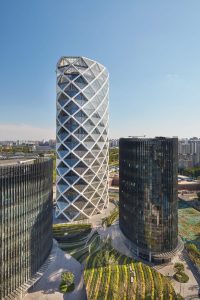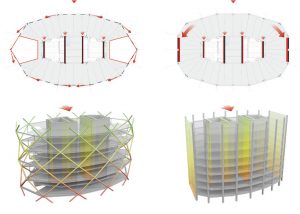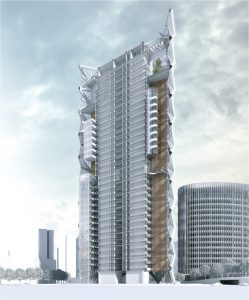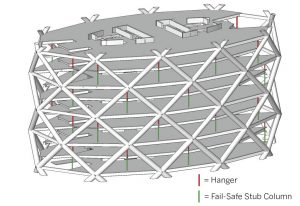Evolution of an Icon
Overview
A chance to design an “iconic” building is not something one encounters every day. However, that is exactly what the designers at Skidmore, Owings and Merrill LLP (SOM) in their San Francisco office got when they were challenged to come up with a design for the Poly International Plaza project in Beijing, China. It was a project that would further burnish the already stellar image of the client, the China Poly Group, renowned for its superior quality real estate holdings. The project was to consist of three office towers totaling approximately 1.25 million square feet, one 530 feet tall – the “icon” – and two others, more conventional, about half as tall (Figure 1).
The project site, prominently located beside a curved expressway in Dawangjing, a new and fast-growing business district about halfway between the center of Beijing and the international airport, provided the first of many ingredients for a unique design. Shaped by their location, the curved boundaries of the site gave rise to the curved, relatively non-directional forms of the buildings. The structure and façade of the iconic tower, the focus of this article, were further inspired by origami Chinese paper lanterns, symbols of welcome traditionally hung over doorways and believed to attract good luck. The curved, faceted exterior form of the tower, with staggered nodes at every alternate level set on a four-story module and spaced approximately 60 feet apart horizontally, naturally suggested a “diagrid” exoskeleton structure, one capable of resisting lateral as well as gravity loads.
Beijing is located in a region of relatively high seismicity (similar to Oregon and much of Washington), and the diagrid exoskeleton frame was combined with a central reinforced concrete core to yield a dual system that effectively and efficiently resisted gravity and lateral loads. Constructed using concrete filled steel tubes (CFT) for most of its height, the diagrid frame made it possible, by virtue of the continuous helical load paths it afforded (Figure 2), to transmit loads around corners and permit the creation of grand atriums. Unfilled steel tubes were used at the upper levels where concrete fill was not required. The atriums – approximately 410 feet tall and located at the tower ends – let light into the building interior and provided views to the surrounding areas. They also allowed for the introduction of structurally and visually exciting elements within them, like elevators, conference rooms, and spiral stairs (Figure 3).
Structural steel floor framing, spanning approximately 36 feet between the core and external diagrid frame without interior columns, and composite metal deck slabs constitute the floor framing system of the tower. To avoid imposing significant gravity loads on the diagrid members between nodal levels, and to minimize bending moments in them, intermediate floor levels were pulled back from the façade and hung from the nodal levels immediately above (Figure 4). The three buildings on the site share a common three-story reinforced concrete conventionally framed basement, and the iconic tower rests on a pile-supported mat foundation.
Designers took advantage of the tower’s exterior diagrid system and resulting facets, as well as of its pulled-back and hung intermediate floor levels, to develop a double skinned, glazed exterior wall system with automated operable vents at the horizontal creases. This arrangement created buffer zones in the spaces between the double exterior walls that act to modulate the extremes of Beijing’s climate and the building’s interior environment, reducing the thermal loads on the building’s mechanical systems and saving energy. This expedient served to boost the tower’s sustainability performance, contributing to its goal of a LEED® Gold rating.
Unique Structural Challenges
The unique form and structural system of the Poly tower called for structural design checks and detailing not typically encountered in tall building design. The first challenge was the modularization of the diagrid nodes. The perimeter floor framing connecting the nodes, and the radial framing connecting the nodes to the core, typically had the same spans over the building height making it possible to standardize the depths of these members and their intersections with the diagrid diagonals. Horizontal and vertical continuity plates, with holes to facilitate concreting of the CFT members, were introduced within the node intersections to simplify and standardize their fabrication and erection (Figure 5). Segments of the diagrid, each consisting of a node and diagonal arms, were fabricated in the shop, spliced with welds to previously erected segments in the field, and then filled with concrete.
One of the most significant differences between a conventional exterior frame and a diagrid frame is that the helical load paths in a diagrid structure make it unnecessary for the floor diaphragms to extend all the way to the frame at the ends of the plan (Figure 2). Local and global buckling studies of the diagrid structure, verifying frame stability in the atrium areas, were performed using elastic analysis programs (CSI’s SAP-2000) during the basic design phase. Non-linear analysis programs (CSI’s PERFORM-3D) were used during the performance verification phase, discussed later in this article. A major concern of the project’s structural reviewers in China was the in-plane adequacy of the diaphragms bounding the atriums, and the impact of cracking of these diaphragm slabs in a major earthquake on the buckling stability of the diagrid structure. To address this concern, in-plane trusses were created in the diaphragms at these locations, designed to provide equivalence to the slab diaphragm strength in case they were rendered ineffective.
Diagrid structures tend to bulge in plan as the diagonal modules compress under gravity load, creating circumferential and radial forces in the perimeter and radial floor framing members, respectively, at nodal levels and corresponding stresses in the diaphragm slabs. This bulging tends to reach its maximum value at about one-third of the structure’s height and to decrease at lower levels because of the restraint to spread of the structure provided by the ground level and sub-structure slabs. To ensure reliable structural performance, the axial forces in the perimeter and radial structural members were determined neglecting the contribution of the diaphragm slabs, but the diaphragm slabs were nevertheless reinforced to withstand induced stresses and minimize cracking. At levels where the diaphragm stresses were the highest, delayed concrete-placement zones were introduced to control slab cracking.
Structural Verification
The structural verification process in China requires buildings with non-prescriptive structural systems, such as the Poly tower, to undergo a rigorous review by a panel of highly respected seismic experts selected by the government from academia and industry. The experts not only evaluate the conformance of such code-exceeding structures with the basic design and performance requirements of the codes but also set enhanced performance requirements for key components of such structures. The process considers three levels of seismic hazard: frequent (50-year return, peak ground acceleration [PGA] 0.07g), moderate (475-year return, PGA 0.20g) and rare (2500-year return, PGA 0.40g) earthquake events. Along with various special analysis and design checks, non-linear time history analysis is required to verify conformance with the enhanced performance goals set by the seismic expert panel. In the case of the Poly tower, this included no local or global buckling of diagrid members in the rare earthquake events, ensuring that nodes would not fail before the diagrid members, and ensuring gradual lateral strength loss of the structure progressing to eventual failure.
Progressive collapse studies were required to ensure that, in the event of the catastrophic loss of a critically loaded diagrid member, enough redundancy and alternative load paths could be activated to ensure life safety. As a fail-safe precaution in the event of a hanger failure, stub columns were provided below the hangers with socketed slip connections at their bases. These are intended to engage and to transmit load to the framing of the level below if a hanger fails.
To verify the procedures used for the design of the diagrid nodes, finite element analysis and scaled pseudo-static gravity plus lateral load testing of nodes with and without concrete fill was performed. Testing showed, as predicted by analysis, if the nodes were not filled with concrete, failure would occur due to buckling of the steel plate walls within the nodes. The wall thicknesses were set to avoid buckling of steel plates within the nodes in the accidental condition where concrete did not completely fill the nodes. This was generally found to not exceed two times the wall thickness of the diagrid members outside the nodes.
Conclusion
SOM was given a unique opportunity to design an iconic building at a prominent location in the new and fast-growing Dawangjing business district in Beijing. Opportunities presented by the site and cultural inspirations gave rise to a building which evolved to integrate form, function, structure, building systems, and sustainable design synergistically to create what is hoped is a memorable design.▪





